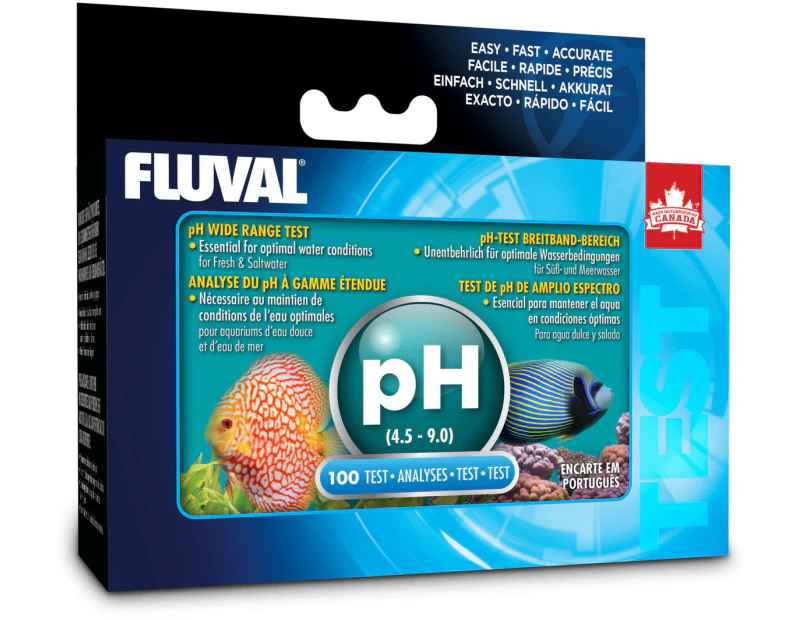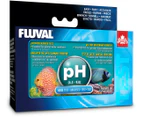Fluval pH Wide Range Test Kit (100 tests) (A-7868)

Fluval pH Wide Range Test Kit (100 tests)
Highlights - Fast and accurate liquid test to measure the pH of your aquarium
- Essential for optimal water conditions
- Store in a cool, dry place
Overview Accurately measure the pH of your freshwater or saltwater aquarium with the Fluval pH Wide Range Test Kit. The common cause of fish fatality is due to pH variations. Fish can adapt to various pH levels, if not broadly out of range, but they can't adapt to values that continually fluctuate. In order to maintain a balanced and healthy environment for the fish and plant life in your aquarium, you need to test the pH weekly. 100 tests per kit. For freshwater and saltwater.
Kit includes:
1 x pH (10 ml)
1 x Pipette
1 x Glass test tube
Instruction booklet
More Information WHAT IS pH? pH is an abbreviation for potential hydrogen. It represents the concentration of H+ ions in a liquid solution. This concentration of H+ ions determines if water is acidic, neutral or basic (alkaline). The scale of pH is from 0-14 (100 to 10-14). Neutral is defined as 7.0. Acidic pH is under 7.0 and alkaline and/or basic is over 7.0.
WHY ANALYZE pH? The pH of water is one of the most important parameters to measure because numerous biological processes depend on pH. The pH plays an important role in the blood systems of aquatic organisms. Broad fluctuations can severely affect them. It is recommended to test the water weekly at different times in order to chart changes that can affect the well-being of the aquarium inhabitants. Always test pH before adding fish.
The pH also affects the toxicity of ammonia present in the aquatic habitat. When the pH is high, the concentration of toxic ammonia is greater. When pH is below 7.0, most of the ammonia is in a nontoxic form. The amount of toxic ammonia increases dramatically when the pH is over 8.0. It is highly recommended to test pH to determine if any toxic ammonia is present.
HOW DOES THE TEST WORK? 1. Take a sample of the water to be tested with the pipette and use it to fill a clean test tube to the 5 ml line.
2. Add 4 drops of reagent into the test tube. Insert cap. Hold in place with finger and shake well to mix. Attention! Always use the cap. Avoid skin contact.
3. Immediately match the test color to the closest color on the chart. For best results, hold the test tube flat against the paper and read with a light source behind you.
4. After use, rinse the tube with fresh tap water to ensure it is clean for next use.
EVALUATING THE RESULTS Many species require acidic conditions (acidophiles) while others are more comfortable in alkaline water (alcalophiles). It is strongly recommended to ensure proper pH before any fish are added to the aquarium.
pH below 6.0: Too acidic for most species of fish. Adjust pH accordingly. pH normally decreases over time. Bacterial activity (nitrification) uses carbonates present in the water, progressively reducing the pH. Frequent and regular testing reduces the chance of this going unnoticed. Never change the pH by more than 0.5 per day to limit stress on aquatic inhabitants. Photosynthesis and denitrification increase the pH, but it is rare to see a sudden rise of pH in aquariums.
The pH of saltwater should never be less than 8.1. Correct any deficiency so that the level is between 8.1-8.3. Use only a buffered product designed especially for saltwater. Do not change pH by more than 0.5 per day to limit stress on aquatic inhabitants.
Stable pH and KH (carbonate hardness) are critical for fish and plant health and condition. Test on a regular basis and adjust pH and KH values easily and safely with a pH adjustment additive (for pH) and a KH Booster (for KH).
‘Don’t Pay’ is the recommended retail price provided by the supplier or obtained from the manufacturer, or is the recently advertised price for the same product on a different or competing online platform or store. Catch may not have previously sold the product at the ‘Don’t Pay’ price.
